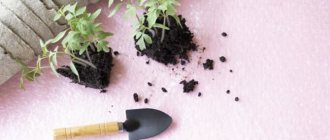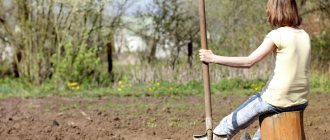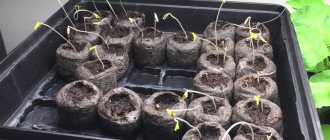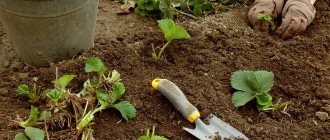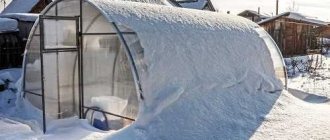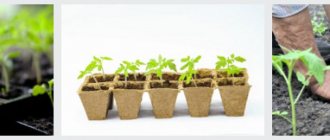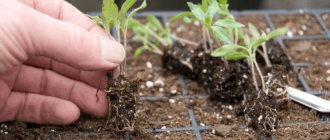What kind of lunar calendar is this?
To begin with, many greenhouse owners rely on the lunar calendar when planning to plant tomatoes. Its main feature is that nature has its own “favorable” days for planting seedlings in each new season.
But, if you are not guided by such manuals, plan the preparation and planting of seeds so that the finished seedlings are taken to the greenhouse at the right time. And the seedling period of greenhouse tomatoes is from 45 to 65 days, and in unheated greenhouses they are planted on the 15th-20th of March.
Density and pattern of planting tomatoes in a greenhouse
Many gardeners today prefer to grow juicy and tasty tomatoes, which contain large amounts of vitamins, in their own greenhouse. This matter has its own nuances and secrets, and one of the important points that both experienced and novice gardeners need to know is the scheme for planting tomatoes in a greenhouse. How to properly prepare the place for planting seedlings, what is the density of placement of bushes in the ground, at what distance from each other should they be placed?
Landing location
Tape two-line scheme for planting tomatoes
The initial stage of planting seedlings of your future tomatoes is preparing the greenhouse itself, the place for planting vegetable crops and seedlings. Many beginning greenhouse growers do not take this important stage of preparation seriously, although it determines how quickly the fragile seedlings can adapt to the artificially created indoor conditions for them, and what the expected tomato harvest will be in the future. Therefore, already 10 days after the start of planting seedlings in a greenhouse, the soil should be disinfected, since most pathogens prefer to be in it. First, you need to remove the top 10 cm layer of soil, and treat the remaining part with a well-proven solution of well-known copper sulfate - to make it, take a tablespoon per 10 liters of water.
Experts do not recommend planting tomatoes in one place for several years in a row.
After you have disinfected the soil, you should loosen it, remove unnecessary weeds, and then fertilize. Most often, for these purposes, it is customary to use about 8 kg of humus, adding a glass of charcoal to it. This mixture needs to be fed to the future site for planting seedlings. Instead of such a mixture, you can also use a bucket of coarse sand or expanded clay per square meter of soil. Loamy or sandy loam soil is best suited for tomatoes. Tomato seedlings must be planted in heated soil - the temperature at this moment at a depth of 15 cm should not be lower than 14 degrees. To achieve this effect, the soil is first covered with black film.
It is also permissible to pour warm water directly into the holes before planting. Thanks to heated beds, planting tomatoes becomes possible several weeks earlier than generally accepted norms, and inside the greenhouse the microclimate necessary for the harmonious growth and development of vegetable crops is achieved. Immediately before planting tomatoes, the soil must be watered with a solution of the well-known potassium permanganate, which has a temperature of about 50 - 60 degrees. This solution is prepared at the rate of 1 g of potassium permanganate per 10 liters of water. As for the greenhouse itself, it will need to be covered with another layer of thick film to provide additional insulation and provide reliable protection to the inner layer of the material, extending its service life.
Pattern, density, distance
As for the optimal size of holes planned for planting, a lot depends on the variety of tomato seedlings that you choose for your greenhouse. According to generally accepted standards, for low-growing types of tomatoes it is necessary to plan holes of about 20 cm, and for tall ones - 30 cm. It should not be surprising that the holes begin to be prepared a week before planting the seedlings, because, as mentioned above, they should be placed in warm soil so that your seedlings do not start to get sick and eventually die.
Before planting, the seedlings are hardened off (two weeks before planting in the greenhouse) and treated to protect them from pests. This should be done five days before planting in the ground using a solution of boric acid. A couple of days before planting, you should also tear off the lower leaves of vegetable crops. It is unacceptable to plant seedlings too deep so that they do not go to the roots. The seedlings should be placed vertically and covered with the prepared soil mixture at a level that coincides with the level of the recess in the seedling box, but only if they have not yet stretched out too much. If they have already stretched out, the stem is not buried in the soil. Also, you should not add too much fertilizer to the soil, because if you overdo it and put it in every hole, you may end up with not bushes with tomatoes, but a large green tree.
Scheme for planting tomatoes in heated greenhouses
It is recommended to plant tomatoes in the evening on a cloudy day and in soil that has been previously moistened to the desired condition. First, holes are made about 12 cm deep, and another hole is also formed in each of them. After this, we install a pot with a seedling and sprinkle it with earth. The second hole will need to be filled in 10 - 12 days after the culture has taken root. This applies to overgrown seedlings; seedlings of normal length are moved into the ground without pots. Before this, each of them is carefully examined for damage, then warm water is poured into the hole and the plant is planted.
The density of planting future tomatoes in the ground should be as follows - low-growing varieties, which are usually formed into several stems, are planted in the well-known checkerboard planting pattern in two rows. According to the rules, the distance between the rows should be 50 - 60 cm, and between the crops themselves - about 40 cm. Standard and determinate varieties of tomatoes, which will form into one stem, can be planted somewhat thicker - make a distance of approximately 50 cm between the rows, and between plants – 35 – 40 cm.
As for indeterminate species, they are not planted so densely; the distance between rows should be about 40 cm, between bushes - approximately 70 cm, and the path that separates the rows should be 100 cm long. This planting pattern is called strip-nested or multi-line , since 2 – 3 rows of plantings form a kind of stitch or ribbon. The square-cluster or square method of planting is also often used - at the intersection of the marker trail made in advance, from one (square method) to two to four (square-cluster or parallel method) tomatoes are planted. To summarize all of the above, the planting density of plants should ideally be such that each of them does not experience discomfort, receives enough sunlight, nutrients from the soil and can develop normally in the area allocated to it.
Video “Recommendations for planting tomatoes”
In the recording, the vegetable grower talks about growing tomatoes, the necessary conditions for growing and the planting method.
plodovie.ru
When to prepare a greenhouse?
Basically, the timing of planting seedlings depends on two main factors:
- Factor #1. The climate of a particular area and its agricultural traditions.
- Factor #2. The microclimate of the greenhouse, namely the features of its design and the presence of heating or the installation of “warm beds”).
For example, in the north of the country, where the spring weather until the summer solstice can “delight” with night frosts, it is not worth planting tomato seedlings in a greenhouse too early. And even with well-arranged warm beds - only in April. But it is possible to bring the deadlines closer in any case and under any conditions: build another greenhouse inside the greenhouse. Simply install arcs over the selected bed and cover them with double film.
Another option is to use modern covering material:
The timing of planting tomatoes for seedlings depends on the region
Planted a tomato and picked a tomato
There is probably not a single person on Earth who has not tried tomatoes. Although some will argue that they did not try them, but feasted on tomatoes. Want to know what the difference is? Then read on. A tomato is a plant, and a tomato is not a vegetable, as is commonly believed, but the fruit of a plant called a tomato. According to the botanical classification, a tomato is a berry, as, by the way, are watermelon, rowan, and lemon. But this is how botanists classify them. We, ordinary people, will consider, as before, tomatoes as vegetables and everything that Mother Nature gives us, we will consider this:
- everything that grows in the garden and is prepared for the winter by pickling is vegetables;
- what is cooked with jam, jam, compote, using sugar - berries;
- everything that grows on a tree is tasty and sweet - fruits.
We sow seeds on time
In Russia, in most regions, tomatoes are grown from seedlings that are sown on a windowsill or in a heated greenhouse. In the southern regions of Ukraine, vegetables can be obtained by direct planting in the garden. The timing of planting tomatoes for seedlings depends on the regions. So, in the central regions of Russia this is done from late February to mid-March. First, seeds of early varieties are sown, so that later they can be planted as seedlings in greenhouses (unheated), after a week and a half - mid-season varieties, and after another week - late varieties. In Ukraine and southern Russia, the timing of planting tomatoes for seedlings is different. They start in mid-February and end in early March. The same vegetable growers who grow early produce in greenhouses are shifting the timing of planting tomatoes for seedlings even until mid-January (for early and medium varieties). In the case of sowing seeds directly into the ground to obtain plants, it must be taken into account that approximately 40-50 days should pass from germination to planting of seedlings in the garden bed. Take this circumstance into account, especially in those regions where night frosts are possible even in May, and do not leave young seedlings without shelter. For late-ripening varieties, the timing of planting tomatoes for seedlings can be shifted to summer by 7-10 days, i.e. sow seeds in early March.
As you can see, in order to obtain planting material, you need to take into account several factors:
— the region with its spring weather conditions;
— variety of tomatoes: early, medium or late;
— and how the plants will be grown in a greenhouse or in open ground.
Based on these conditions, the timing of sowing tomatoes for seedlings is regulated.
Picking is important
The next step when growing tomatoes is picking, that is, transplanting small sprouts to another place. It is convenient to use plastic cups for this. They do this to increase the feeding area of each plant. When picking, pinch off up to 1/3 of the root so that the root system develops better. Then the tomato is immersed down to the cotyledon leaves in the ground and compacted around the stem.
And then - to the garden
The time for planting tomato seedlings in the ground usually occurs after frost. In the south this may be at the end of April, in the central and more northern regions at the end of May - beginning of June. Before transferring the seedlings to the garden bed, it is necessary to harden them, i.e. accustom to cool air at night and bright sun during the day. To do this, the plants need to be taken out into the open air in the morning, preferably in the shade for a couple of hours. The time the tomatoes spend in the yard or on the open balcony is gradually increased to the whole day and night. For large plantings of tomatoes for harvesting or for sale, the deadlines can be shifted by a few more days.
syl.ru
We grow seedlings on time
After seedlings appear, move the seedlings to a bright and cool place. At night, maintain the temperature at 14-16°C, and after a week increase it to 20°C. Additionally, open the window slightly at night to lower the temperature to 15°C - this is a kind of light hardening.
Additionally, you can make special lighting for growing seedlings. At first, until the first shoots appear, you can get by with incandescent lamps - 12-16 hours a day. But you will need to turn on the lights for the whole day after four days.
Water the seedlings with warm water and little by little, because... Tomatoes, unlike cucumbers, do not like waterlogged soil. But it is also important not to let the soil dry out - spray it periodically. Water yourself once a week. And after the appearance of the first five true leaves - only once every four days.
You can also grow tomato seedlings for a greenhouse in the following containers:
- Egg shells, after making a small drainage hole at the other end.
- Plastic film in which we wrap the seedlings and some soil. Over time, we gradually add soil, carefully unfolding and “wrapping” such diapers.
- In a jar of water. We cut off all the sprouts at the root and place them in plastic glasses with water. New thin roots appear there, with which we plant them in greenhouse beds. In some cases, with proper care, this method can even increase productivity.
Just before planting, the tomato seedlings are picked. This operation is important because it immediately gives the plants powerful growth, significantly accelerating vegetative maturation.
Preparing seedlings
Tomato seedlings Seedlings
are grown in pots, the soil and seeds are pre-treated with potassium permanganate. When 4 leaves are formed, the seedlings dive. After 2-3 weeks, the picking is done again. Light, warmth and regular watering are the main components of properly grown seedlings.
Before planting, it is recommended to harden the seedlings. To do this, open the windows in the room, and you can also take the seedlings outside for several hours. A week before planting, it is worth treating the seedlings with boric acid as a disease prevention measure. Before planting, it is recommended to tear off the lower leaves. This will speed up the plant’s adaptation and development process.
Properly prepared seedlings have 8 leaves, a thick strong trunk and a well-developed root.
What to do if seedlings grow too quickly?
A typical situation: you are preparing a greenhouse for a certain date when, without additional heating (which in itself is already a luxury), it will be possible to plant tomato seedlings and begin the careful chores of growing them. But something didn’t go according to plan: the ground in the greenhouse is cold, weather forecasters promise night frosts for another two weeks, but your seedlings are ready now! And the conditions you created are no longer enough for her. Of course, it is possible to plant overgrown tomatoes in a polycarbonate greenhouse, which we will discuss below, but this will not lead to a rich harvest. What to do then?
If you realized it in time, then we urgently stop the growth of the seedlings. For example, by reducing the amount of watering and removing fertilizing, or more radically: we cut off the top of the seedling, about 20 cm long, remove all the lower leaves and return it to the pot in this form. Alternatively, in a jar of water.. This way the seedlings will again take new roots, which will take time and effort. Additionally, you can help your tomatoes by keeping such tops in the Kornevin solution for about a day.
Moreover, such operations can be repeated, and more than once, until your polycarbonate greenhouse is completely ready for planting tomato seedlings. You will be surprised, but by summer you will already have quite strong bushes growing, although, frankly speaking, you scoffed at the planting materials. But, as they say, what doesn’t kill you makes you stronger.
Tomato varieties for the greenhouse
In regions with changeable weather and cool summers, gardeners are increasingly installing polycarbonate greenhouses. They serve for a long time without deformation and are easy to maintain. The most productive varieties for closed beds:
- Early - Alliance F1, Sweet Bunch, Miracle of the Earth, Pink Raisin.
- For the Moscow region - Nevsky, Bull's Heart, Blagovest.
- For the Urals - Titanic F1, Bicolor, Abakan pink.
- Large-fruited - King, Mikado, Sevruga.
For growing in greenhouses, you should purchase varieties that are resistant to late blight and fungal spores: Fenda F1, Fantasio F1, Gilgal F1. The listed hybrids produce high yields and are not demanding of care. For conservation, you can plant De Barao, Eagle Beak or Golden Domes bushes.
Important! When growing tomatoes in regions with short summers, gardeners prefer to plant seedlings of self-pollinating tomatoes: Mikado, Cardinal, Caspar. They do not require insects, which greatly simplifies work in the greenhouse.
What if the seedlings still outgrow?
But what to do if the tomato seedlings have managed to outgrow? And what if you outgrow it seriously? Don’t be upset - in any situation, as you know, there are two ways out, even if you were eaten. And here are three:
Method No. 1. Shorten the stem
This method is especially popular abroad. There, lovers of everything environmentally friendly when growing seedlings do not worry at all about the fact that they are “too elongated.” Yes, even up to half a meter is not a problem: three days before planting in the greenhouse, we take these lanky plants, and with a sharp blade treated in alcohol, we cut off the stem at the very root and at the very top. And definitely at an oblique angle! Then we connect these two parts together and seal them with regular tape. We continue to water and care as usual. As a result, tomato seedlings turn out strong, healthy, with a thick short stem and a strong root system. Brilliant, isn't it?
But, if you have no particular desire to engage in such delicate and painstaking surgical operations, then do it according to the second method - we hide all the flaws in the ground.
Method No. 2. We are tricky when landing
So, if the seedlings are a little overgrown, we do this:
- Step 1. We make ordinary holes in the greenhouse, but right in the center there is another depression the size of the container in which we grew the seedlings.
- Step 2. We remove the seedlings from the walls of the container (cut them, for example), and insert the ball with roots into this central hole. We press the soil around.
- Step 3. We do not fill the hole itself with soil for two weeks - let the seedlings take root.
- Step 4. After this period, we insert a peg into the ground and thus tie up the plants.
- Step 5. Fill the soil up to the level of the entire bed.
It will grow, believe me.
Method No. 3. Hiding the “tail”
But this method is the only way out if the tomato seedlings have not just stretched out, but have become very overgrown. So, if the seedlings are longer than 60-70 cm, we plant them a little differently:
- Step 1. Dig long furrows in the garden bed and water well.
- Step 2. Now we take the seedlings and pinch off all the lower leaves on the stem to the 50 cm mark.
- Step 3. Place the seedlings in a horizontal position directly on the grooves, slightly deepening only the root system. Only the top of the head should remain 25-30 cm above the ground.
- Step 4. Fill the grooves with the stems with soil and water.
- Step 5. Carefully tie the crowns to pegs to point them vertically.
It is important to leave as much of the plant above the ground as you need, and the buried part of the stem will send out additional roots in the moist soil.
But such seedlings cannot be hilled or loosened, because... The roots here are located too close to the surface and are easy to damage. And it is also important to ensure that the soil surface does not dry out, so instead of exhausting spraying, simply mulch it.
Features of caring for tomatoes in greenhouse conditions
Caring for tomatoes is not difficult. A standard set of work, completed on time, will guarantee the creation of the best conditions for the formation and ripening of fruits.
Watering
After planting the tomato in the greenhouse, after a week and a half, water the plantings. Use water at a temperature no colder than 21 degrees. Direct the watering can under the root so that less moisture falls on the leaves of the tomato bushes.
Watering should be plentiful, but infrequent. 10 liters of water per square meter is enough. m of bed before the tomato blooms and 30 liters of moisture per sq. m. m of land with the onset of the fruiting phase. Otherwise, the beds will become swampy from excess moisture and the air will become humid. This will lead to the development and spread of fungal diseases and root rot.
At the first signs of rot and spotting, stop moistening the soil and treat the plants with antifungal drugs. Fundazol, Skor, and Maxim are suitable for such purposes. Use them strictly in accordance with the instructions, using personal protective equipment.
Make sure the soil does not dry out. Drought entails a stop in crop growth and a slowdown in fruit formation. After each watering, ventilate the greenhouse to remove excess moisture from the air.
Loosening
Loosen the soil a day or two after watering so that a dense crust does not form on the surface of the earth. This procedure increases the aeration of the root system and retains moisture in the soil longer. Mechanical impact on the ground destroys the larvae of insect pests at the roots of the tomato.
Stepsoning
Pinching is the formation of a tomato bush by removing peripheral shoots. During the growing season, the growth of stepsons consumes a lot of nutrients and plant strength, but this does not increase the amount of harvest. If you pinch off these shoots, the density of the planting and the leafy green mass of the plant will decrease. In this case, the loss of nutrition will be stopped, and crop formation will be optimized.
Pruning is carried out 10-15 days after planting the seedlings. Carry out such work in sunny weather so that the wounds on the stem heal quickly without harm to the crop.
To form a tomato bush into 1 stem, all stepsons are removed. If you need to form a bush with 2-3 stems, then remove all the stepsons, leaving one under the flower brush and 2 stepsons above it.
Periodically look through the tomato bushes, avoiding the growth of fattening shoots more than 3-5 cm in length. Break them off with your hands or cut them with garden shears.
Garter
For low-growing tomato varieties, installation of supports and garter is not required. They do not grow in height, but bush in width.
Tall tomato bushes must be tied up no later than 2 weeks after planting in the greenhouse. Otherwise, they may break off under the weight of their own. For the procedure, wooden stakes and garter material are used:
- Sink the supports into the ground next to the tomato plant.
- Be careful not to harm the plant's roots.
- Tie the stem to the stakes so as to balance the load without damaging the bush.
It is better to use garters made from old cotton rags or special plastic clamps (disposable and reusable). Nylon ropes can dig into the stem as the seedlings grow.
Top dressing
It is recommended to adhere to the following fertilizer application schedule:
- 3 weeks after planting, fertilize. For this, 2 tsp. mix organic fertilizers (for example, Agricola Vegeta) with 1 tsp. nitrophoska and dilute in 10 liters of water. The consumption rate of the nutrient solution is 1 l/bush.
- 2 weeks after the first feeding, repeat. For this, 1 tbsp. l. Mix Agricola for tomatoes with 2 tbsp. l. Effekton-O fertilizers, dissolve in 10 liters of water.
- Carry out the third feeding 10-15 days after the second. Dilute 1 tbsp. l. superphosphate and 2 tbsp. l. "Agricola Forward" in 10 liters of water. After applying fertilizer, water the beds to evenly distribute nutrients in the root zone.
How to deliver seedlings to the greenhouse unharmed?
If you will be transporting tomato seedlings for the greenhouse from afar (for example, from home to the country), then it is better to prepare them for transportation in the following way:
- Step 1. Count 4 leaves from the bottom and cut off the top. We put this top in a jar of water, covering it from direct sunlight.
- Step 2. After 6 days, when the roots are already visible on the seedlings, remove it from the jar and wrap each variety in a separate damp soft cloth.
- Step 3. We place such “packages” in small plastic bags so that the leaves are slightly open.
- Step 4. Place all this in a small cardboard box (horizontally) and close it. Just first line the bottom of the box with film and cover the seedlings with it so that the water does not evaporate on the way.
Believe me, you will deliver tomato seedlings to the greenhouse without any problems! Moreover, this method also has additional, important advantages:
- You can even plant tomato seedlings in a greenhouse the next day, if you just place all the bundles in water overnight.
- You no longer need to worry that the seedlings will stretch.
- New roots for tomatoes make it possible to achieve a much larger harvest. Moreover, this method has been described more than once in gardening magazines and related books.
Speaking of “roots” and “tops”. Indeed, if you cut overgrown seedlings in half and plant them side by side after the roots have sprouted, the “tops” will yield 20% more yield.
Greenhouse and soil preparation
Before planting tomatoes in a greenhouse, it needs to be prepared. If everything is done correctly, you can move young plants or sow seeds for seedlings quite early.
Soil development
Plant tomatoes in warm, fertile, moist, loose soil. Bringing these parameters into line with cultural requirements requires separate consideration.
Improvement of structure and fertilization
There is no need to dig up the garden every year. Tomatoes and other annual crops growing in separate bushes are planted in holes, where organic matter and fertilizers are added, and that’s it. This is not done in protected ground.
The beds are completely dug up, preferably in the fall. Add organic matter and fertilizers:
- Do not add nitrogen to the soil at the end of the season - it will be washed away until spring;
- phosphorus and calcium, on the contrary, begin to “work” only after a long period; they are recommended to be added in the fall.
Once every few years you can completely change the substrate. Or you will have to move the greenhouse to a new location every season.
Moisture saturation
If winter is rich in precipitation, and gardeners live in a private house, it is enough to throw snow inside the structure. In the spring it will melt and the soil will be saturated with moisture. Otherwise, you will have to wet the bed at least enough to fill a spade. This is approximately 26 cm. In order for the water to reach the required depth, you will have to water it repeatedly.
Temperature increase
The faster the ground warms up, the sooner you can plant tomato seeds or seedlings. The temperature should be increased only after moisture charging:
- Pour hot water over the bed and cover with foil.
- Cover the area with black non-woven material. The method works exclusively in sunny weather; it will take a much longer period of time.
You will have to measure the soil temperature with a special thermometer. You can use the cheapest cooking probe.
To prevent the earth, which has been heated during the day, from cooling down at night, it is protected at sunset with an additional layer of insulation.
Disinfection
The soil, especially if nightshade crops were planted in the same place in the previous season, must be disinfected in any convenient way, for example, with solutions:
- copper sulfate;
- Fitosporina;
- Trichoderma;
- Carbation;
- Baikal.
You should first read the instructions for the selected drug. Some are used immediately before planting, others – at least a month in advance.
Greenhouse preparation
The structure needs the same care as a greenhouse. All parts, no matter whether they are removable or have stood all winter, and protective coating:
- cleaned mechanically;
- wash;
- disinfected.
Covering material is pulled over the arches 7-10 days before sowing or planting tomatoes.
Insulation
The greenhouse is designed to plant tomatoes or sow seeds as early as possible. It is not heated, therefore, it needs protection from sudden cold snaps, because if the threat of a critical drop in temperature did not exist, then the structure itself is not needed.
We'll have to keep an eye on the weather forecast. During the day, the sun heats the bed; when it’s cool outside, it’s hot inside. But at night, seeds and plants can freeze.
It is recommended to prepare warm old blankets and “out of order” outerwear in advance. As soon as a cold snap is predicted, the structure is insulated in the evening. When the sun comes out, the shelter is removed.
How to plant tomato seedlings with a strong root system?
Proven fact: the more developed the root system of a plant, the stronger the seedling itself will be and the larger the future fruits. And with tomatoes this is quite easy to achieve.
Kazarin method
So, this method is called the Kazarin method, and its essence is the dry method of growing greenhouse tomatoes. We initially grow such seedlings in extreme conditions - without watering at all. Then rooting occurs along the stem, which is overgrown with a large number of additional roots. They look for at least a little moisture wherever they can, and this causes them to grow quickly. Moreover, this method is applicable practically only to tomatoes - moisture-loving cucumbers would have withered away long ago from such experiments. But tomatoes, on the contrary, grow stronger and enjoy life.
Here are more detailed step-by-step instructions on how to do this:
- Step 1. We make holes in the form of grooves, no more than 10 cm deep.
- Step 2. Add half a bucket of compost mixed with a glass of ash and 1 gram of potassium permanganate to each hole. Mix with soil.
- Step 3. Now pour half a bucket of water into each hole.
- Step 4. We take the picked seedlings in our hands and visually divide each plant in half. We tear off all the leaves from the lower conventional part.
- Step 5. Place part of the stem without leaves directly into the grooves and cover them with soil. We leave the crown lying on the ground - there is no need to bend it, so as not to break it, it will stretch up on its own and later you will tie it up, like ordinary bushes.
- Step 6. Pour another half a bucket of water on top.
That's all! Throughout the summer, we water the tomatoes only once every two weeks, and then only a little (in the open ground, we don’t water them using this method at all, counting only on rare rains). At first it will be difficult for you to overcome the psychological barrier - the plants will begin to wilt a little, and some leaves will even shrink, but after two weeks the bushes will straighten out and begin to grow a powerful root system. The harvest will be rich and unexpectedly tasty!
Growing seedlings and picking
Grown and hardened seedlings are planted in the greenhouse. To grow it you will need:
- peat cups or long containers;
- prepared seeds;
- nutrient soil;
- some tools.
- Soil is poured into peat cups or containers.
- Then small holes are made in the ground for planting seeds, which are sprinkled with a thin layer of earth on top.
It is more convenient to grow seedlings in peat cups, because in this case no diving is required, which can damage the delicate root system. If the seedlings were planted in a container, with the appearance of real leaves, a pick is carried out, planting the young plants in separate containers.
